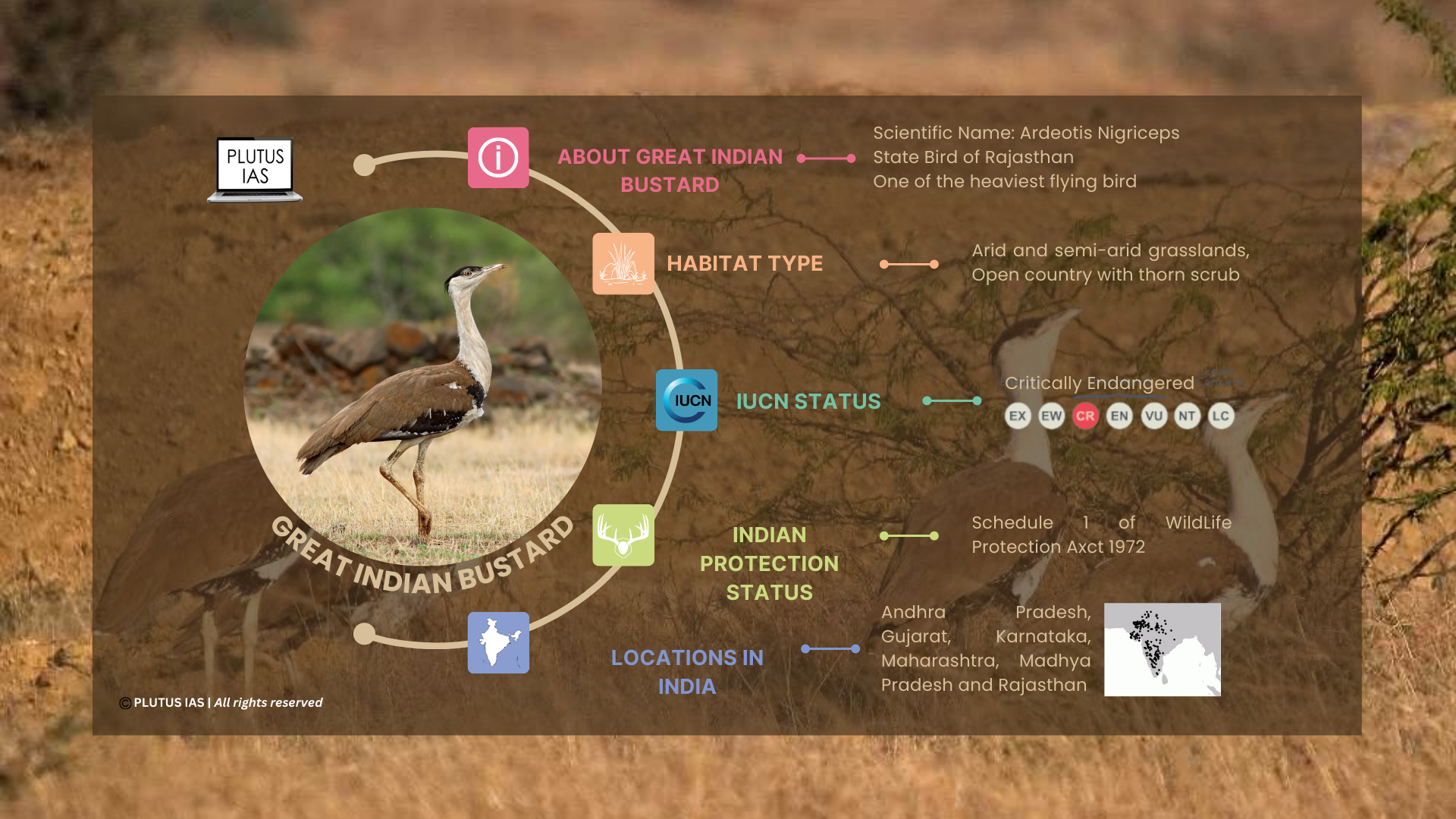07 Mar GREAT INDIAN BUSTARD
GREAT INDIAN BUSTARD
This article covers “Daily Current Affairs for UPSC” and the topic details about the Great Indian Bustard. There are less than 100 birds today, which is a dangerous sign for its existence.

Great Indian Bustard
For Prelims:
- About Great Indian Bustard – habitat, IUCN status, Indian Protection Status, and Locations in India
- About Great Indian Bustard Protection Programme
For Mains: GS 3, Environment:
- Issues concerning the survival of Great Indian Bustard
Government Schemes for its Protection CONTENTS:
- Why in the news?
- About Great Indian Bustard
- Issues facing the survival of Great Indian Bustard
- Conservation Programme for Great Indian Bustard
- Way forward
Why in the news?
The draft notification issued by the Central Electricity Authority on the construction of electric lines in the habitat of the critically endangered Great Indian Bustard is a cause for concern. The Great Indian Bustard is already facing several threats to its survival, including habitat loss, hunting, poaching, and collision with power lines. The construction of new power lines in the bird’s habitat could further exacerbate these threats and push the species closer to extinction.
About Great Indian Bustard
The Great Indian Bustard (Ardeotis Nigriceps) is a critically endangered bird species found mainly in India, but also in Pakistan and Nepal. It is one of the largest flying birds in the world, with males weighing up to 15 kg and females weighing up to 6 kg.
The bird is mainly found in grasslands and semi-arid areas, where it feeds on insects, small mammals, reptiles, and seeds. Its habitat has been greatly reduced due to human activities such as agriculture, grazing, and development, leading to a significant decline in its population. It is estimated that there are only around 150 individuals left in the wild.

About Great Indian Bustard
Issues facing the survival of the Great Indian Bustard
faces several issues that have led to its critically endangered status. Some of these issues include:
- Habitat loss and degradation: The conversion of grasslands into agricultural land, urbanization, and infrastructure development have significantly reduced the bird’s habitat. This has led to the fragmentation and isolation of populations, making them more vulnerable to predation and other threats.
- Hunting and poaching: The Great Indian Bustard is hunted for its meat, feathers, and other body parts. The bird is also targeted by poachers who capture it for illegal trade.
- Collision with power lines: The bird is prone to colliding with power lines, which are often located in or near its habitat. These collisions can lead to injury or death, particularly during migration.
- Climate change: Changes in temperature and rainfall patterns can affect the bird’s breeding and feeding habits, and alter the availability of resources in its habitat.
- Lack of awareness and conservation measures: There is a lack of awareness among the public and policymakers about the bird conservation status, leading to inadequate conservation measures and limited funding for conservation efforts.
Conservation Programme for Great Indian Bustard
The Great Indian Bustard (GIB) is a critically endangered species, and several conservation programs have been initiated to protect the species. Some of these programs include
- Protected areas: Several protected areas, including wildlife sanctuaries and national parks have been established to protect the Great Indian Bustard and its habitat. For example, the Desert National Park in Rajasthan and the Great Indian Bustard Sanctuary in Maharashtra are dedicated to the conservation of the GIB.
- Habitat restoration: Efforts are being made to restore the degraded grasslands and semi-arid areas that are critical for the survival of the GIB. Habitat restoration programs involve activities such as plantation, water conservation, and soil conservation measures.
- Captive breeding: Captive breeding programs have been initiated to increase the population of the GIB. These programs involve breeding birds in captivity and releasing the offspring into the wild. The breeding centers are equipped with facilities for the incubation, rearing, and rehabilitation of the birds.
- Monitoring and research: Regular monitoring and research programs are conducted to understand the population dynamics, habitat requirements, and behavior of the GIB. These programs help in developing effective conservation strategies and monitoring the effectiveness of conservation efforts.
- Awareness campaigns: Several awareness campaigns are being run to educate the public, policymakers, and local communities about the conservation of the status of the GIB. These campaigns aim to generate public support for conservation measures and encourage local communities to participate in conservation efforts.
Way Forward
These conservation programs are essential for the protection and conservation of the Great Indian Bustard. It is important to continue and strengthen these efforts to prevent the species from going extinct.
- Strengthen conservation measures: The existing conservation measures such as habitat restoration, captive breeding, and protected areas should be strengthened and expanded to cover a larger area.
- Mitigate threats: Efforts should be made to mitigate the major threats to the species such as habitat loss, hunting, poaching, and collision with power lines. This can be achieved through the development of mitigation strategies, such as undergrounding of power lines, awareness campaigns, and strict law enforcement.
- Research and monitoring: Regular monitoring and research programs should be conducted to gather more information about the population, habitat requirements, and behavior of the GIB. This will help in developing effective conservation strategies and monitoring the effectiveness of conservation efforts.
- Engage local communities: Engaging local communities and raising awareness about the conservation status of the GIB is critical to the success of conservation efforts. Local communities should be encouraged to participate in conservation programs and given incentives for their involvement.
- International cooperation: International cooperation is essential for the conservation of migratory birds like the Great Indian Bustard. Collaboration with neighboring countries such as Pakistan and Nepal can help in developing a coordinated approach to conservation.
- Sustainable development: Sustainable development practices should be promoted in areas where the GIB is found. This will help in balancing the needs of the local communities with conservation goals.
In conclusion, the conservation of the Great Indian Bustard requires a concerted effort from governments, conservation organizations, and local communities. By implementing the above measures, we can ensure the survival of this magnificent species for future generations.
Sources:
Daily Current Affairs for UPSC
Reading daily current affairs helps the aspirant acquire national and international knowledge. There are several benefits of reading daily current affairs for UPSC exam preparation. The aspirants can familiar with the recent incidents happening in the world. The Plutus IAS provides the best latest daily current affairs for the UPSC examination free of cost. Also, read weekly and monthly current affairs for IAS exam preparation.




No Comments